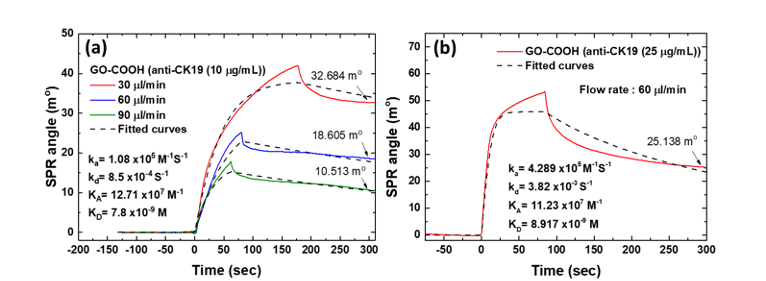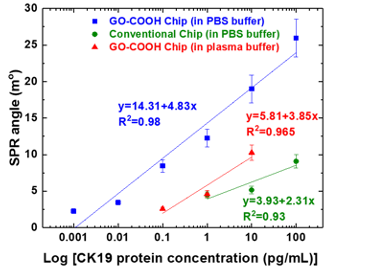This work demonstrates the excellent potential of highly sensitive carboxyl-graphene oxide (carboxyl-GO) based surface plasmon resonance (SPR) immunosensor for the detection of lung cancer for cytokeratin 19 biomarker in human plasma(1). Developed first by Chiu et. al., this novel carboxyl-GO surface (2,3,4) increases the diagnosis sensitivity of non-small cell lung carcinoma detection. The carboxyl-GO chips appeared to be beneficial in detecting the lung cancer cytokeratin 19 (CK19) biomarker due to the high affinity, sensitivity, specificity and ease of use. The lowest detectable concentration was as low as 1 fg/mL. Furthermore, a spiked 10% human plasma CK19 detection limit of 0.05 pg/mL was achieved, well below the normal physiological level of serum protein (3.3 ng/mL) (1).
GO sheets are synthesized using a modified Hummer method, yielding a carboxylate product from chloroacetic acid (Cl–CH2–COOH) under basic conditions. A carboxyl-GO sheet has easily synthesized functional groups, which form unique composites (2). Using an assay with a plasma sample, the preparation of the GO-COOH chip was performed as shown in Figure 1(a).

After activation of the chip, anti-CK19 was immobilized on the surface using the BI-3000G SPR. In Figure 2(a) shows that the shifts in SPR angle at a conformation change after interactions between the anti-CK19 protein (200 uL at 10 ug/mL) and the GO-COOH chip at flow rates of 30, 60, and 90 μl/min were 32.684, 18.605 and 10.513 m° (mDeg), respectively. These results clearly show that the bonding reaction between the antibody and the GO-COOH chip was excellent at a low flow rate (30 μl/min), resulting in an increase in the thickness and density, and exhibiting a relatively large angular shift of the SPR.

Figure 2(b) demonstrates that the probe of 25 μg/mL anti-CK19 molecular adhesions at the carboxyl-GO-based SPR chip at a flow rate of 60 μL/min showed an SPR angle shift of 25.138 m°. The experimental results show that an antibody concentration of 25 μg/mL did not result in a relatively high adsorption bond reaction.
The conventional and carboxyl-GO-based SPR chips response assays to different concentrations of CK19 using the calibration curve obtained with 10% human plasma and PBS are shown in Figure 3. In the carboxyl-GO-based chip, the linear regression equations of the calibration curve were y = 14.31 + 4.83× with R2 = 0.98 for the detection of CK19 in PBS buffer, and y = 5.81 + 3.85× with R2 = 0.96 for the detection of CK19 in spiked 10% human plasma. The linear regression equation was y = 3.93 + 2.31× with R2 = 0.93 for the conventional SPR chip. These results suggest a linear relationship between the SPR angle shift and the direct detection of CK19 in different buffers, which demonstrates the specificity and affinity functionality of this GO-COOH based chip for the detection of CK19 in spiked human plasma.

In conclusion, a carboxyl-GO based SPR biosensor appears to have high sensitivity and specificity for the detection of clinical whole plasma biomarkers and possible application in diagnosing diseases.
This short note is based on the work from Prof. Chiu’s research lab at National Taiwan Normal University.
Author: Nguyen Ly | Biosensing Instrument | Published May 4, 2020
DOWNLOAD PDF
Download a PDF of Application Note 136: Sensitivity and kinetic analysis of carboxyl-graphene oxide-based SPR biosensors for label-free detection of lung cancer biomarker
- N.-F. Chiu, et. al., Sens. Actuators. B Chem., 265, 264-272 (2018)
- N.-F. Chiu, et. al., Biosens Bioelectron. 89, 1, 370-376 (2017)
- N.-F. Chiu, et. al., International Journal of Nanomedicine 14, 6735-67487 (2019)
- N.-F. Chiu, et. al., International Journal of Nanomedicine 14, 4833-4847 (2019)
